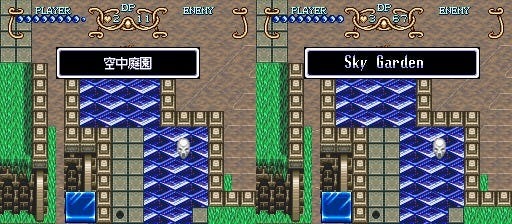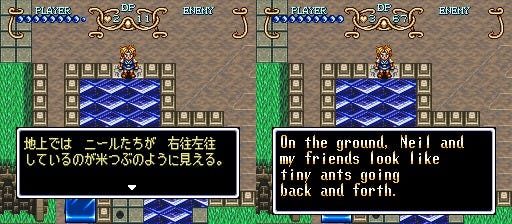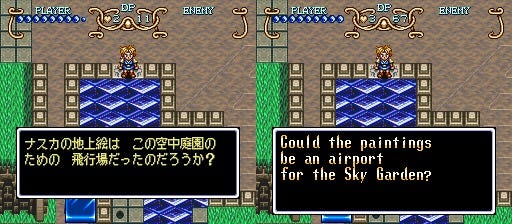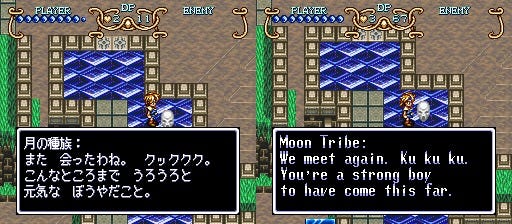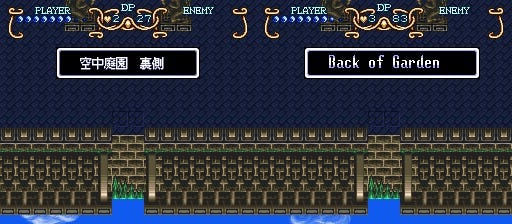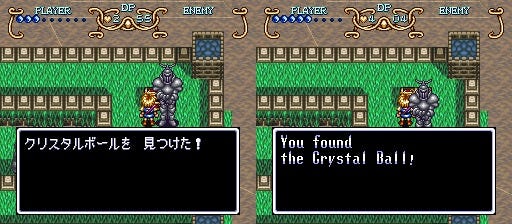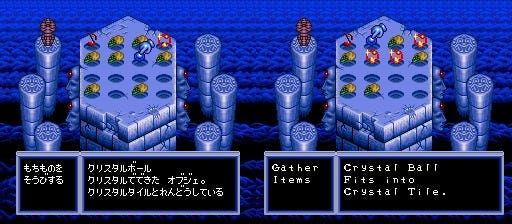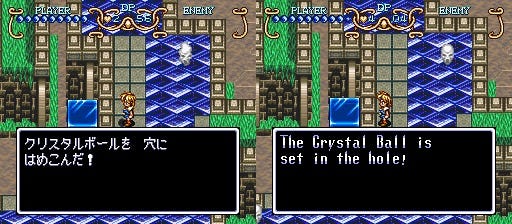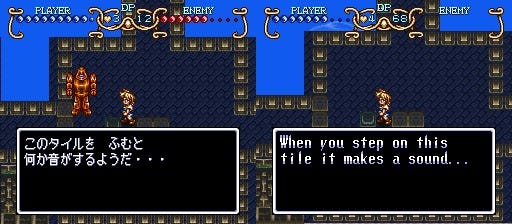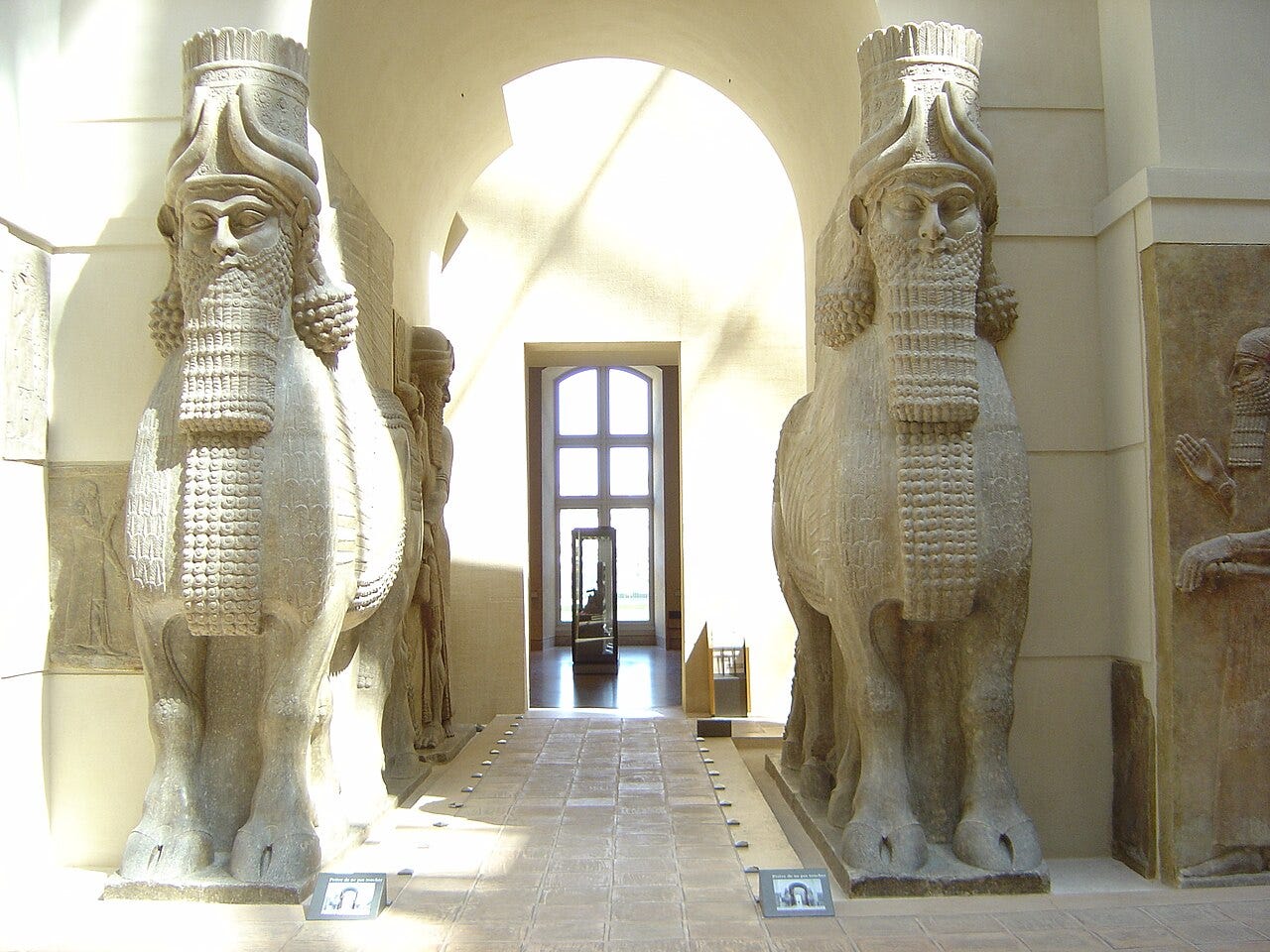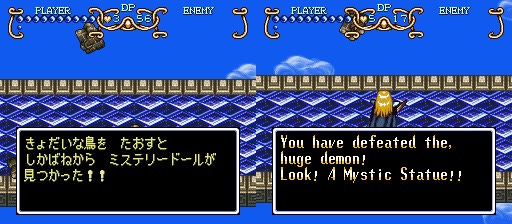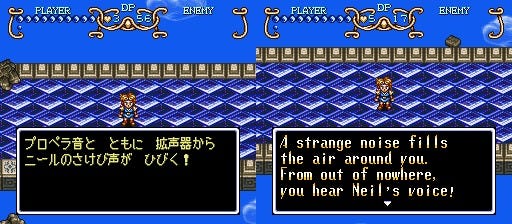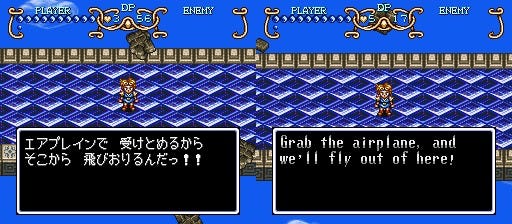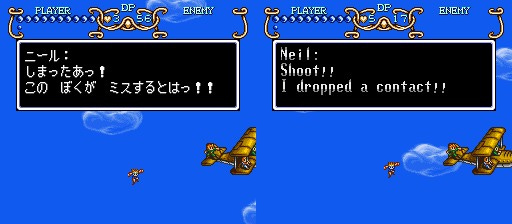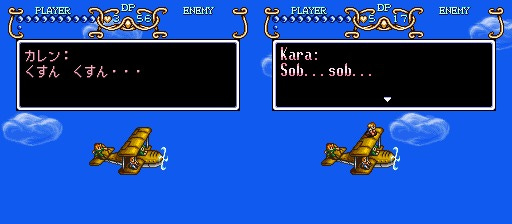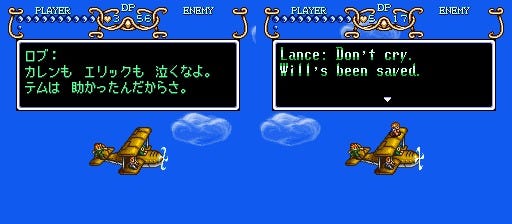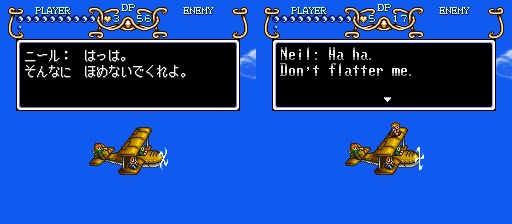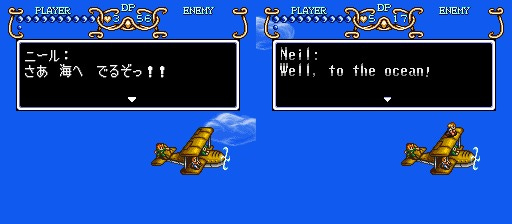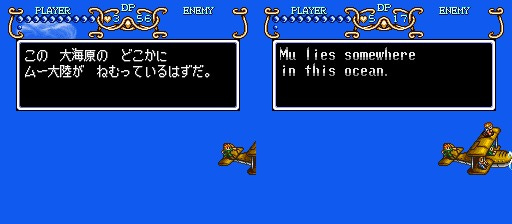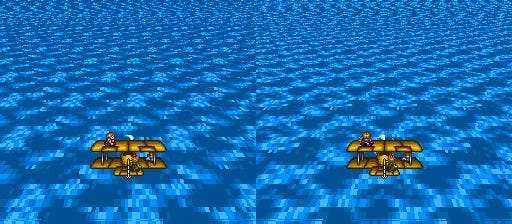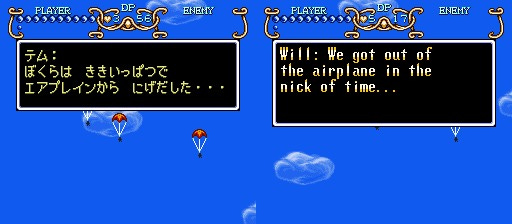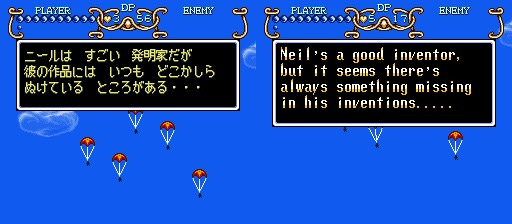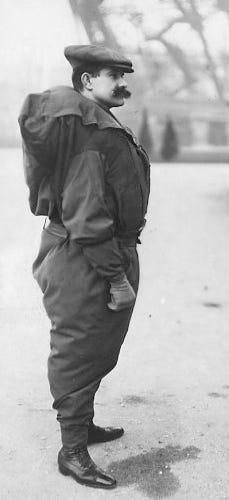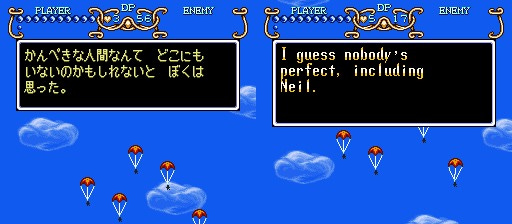Illusion of Gaia Translation Commentary Part 16: Sky Garden, lost contacts, and parachutes
I'm not saying it was the Moon Tribe... but it was the Moon Tribe
Disclaimers:
I’m an amateur. My advantage over the original translation is that I have no deadline pressure, and I have the modern internet to help me. I’m assuredly wrong about some of my translations.
Translation is hard. When I point out a mistranslation, it’s not a judgment of the original translators. They had a deadline and poor resources.
Please no jokes in the comments about Karen being a Karen. I really hate that trend.
Notation reminder:
JP: Original Japanese
T: My translation
OE: Original English
JP: 空中庭園
T: Hanging Gardens
OE: Sky Garden
空中庭園 (kuuchuuteien) does literally mean sky garden. But what we call in English the Hanging Gardens of Babylon are バビロンの空中庭園 (babiron no kuuchuuteien - Sky Gardens of Babylon) in Japanese. Some of the dungeons in this game are famous ancient structures: The Giza great pyramid, the Great Wall of China, and Angkor Wat. Mu is a famous mythical lost continent. The Larai Cliffs aren’t a real location, but (I believe) are supposed to evoke places like the Sarcophagi of Carajía in Peru. (Japanese Wikipedia says it’s modeled on Machu Picchu but I don’t see it. The area outside before you go in the dungeon looks like Machu Picchu, but the dungeon itself is a cliffside tomb with huge in situ statues. Machu Picchu doesn’t have that.)
Point is, every other Mystery Doll containing dungeon is based on a real location or a famous mythical location. I’d assume the Sky Garden is no different; this area is supposed to be the Hanging Gardens of Babylon.
That said, I wouldn’t call this a mistranslation. It’s a joke in Japanese: haha, what if the sky gardens were actually flying in the sky? Because we use a different name, the joke doesn’t work. The translators chose to keep it literal. Since I had the luxury of being able to explain the whole issue, I’ll keep it as Hanging Gardens.
Anyway, didn’t we get here from the Nazca Lines? The f does Nazca have to do with Babylon, which was in modern day Iraq?
JP: テム: ナスカの上空には 不思議な庭園が うかんでいた...
地上では ニールたちが 右往左往 しているのが米つぶのように見える。
T: Tim: There was an incredible garden suspended in the Nazca sky.
From up here, Neil and the rest look like rice grains going this way and that.
OE: Will: There’s a strange garden floating floating in the sky over Nazca…
On the ground, Neil and my friends look like tiny ants going back and forth.
The word 不思議 (fushigi) can mean mysterious, strange, marvelous, incredible, amazing, etc. (You might recognize the word from the Mystery Dungeon series.) Illusion of Gaia seems to translate it as strange a large percentage of the time.
They updated rice grains to ants, which is exactly what a localizer should do. I would’ve done so as well, were I making a romhack. But for the blog I want to highlight these kinds of changes.
JP: ナスカの地上絵は この空中庭園の ための 飛行場だったのだろうか?
T: I wonder if the Nazca geoglyphs were an airfield for these Hanging Gardens?
OE: Could the paintings be an airport for the Sky Garden?
The most common JP word for airport is 空港 (kuukou). This refers to the kind of commercial airport most people are familiar with. 飛行場 (hikoujou) more often means a small local airport, mostly for private planes. I think airfield is a better choice so the two aren’t mixed up. And while most people wouldn’t notice, an overthinker like me will wonder: how the hell does Tim know what an airport is? There’s only one airplane in his entire world! There’s no commercial air travel! But he might know what an airfield is because he already knew about Neil’s airplane before we visited his cabin.
Anyway, Tim reveals what the f Babylon has to do with Nazca. The scenario writers made the Hanging Gardens a flying apparatus and are tying in the Nazca lines by reference to Erich von Däniken’s 1968 book Chariots of the Gods? Däniken is an advocate of the ancient astronaut hypothesis: that many of the ancient wonders of the world could not have been made with the technology of the time, and were the result of technology borrowed from alien visitors (or were created by aliens personally). The book included the hypothesis that the Nazca lines were landing strips for alien spaceships.
And since the game has dipped its toes into this… theory, I’m obligated to bust out this classic meme:
Scholars have since shown how the Nazca lines could have been made with technology known to be available to people at the time. (Probably all it would take is some stakes and rope.) It’s hard to express how unimpressed I am with the argument I can’t understand how/why something was done, therefore it was aliens/gods/the Moon Tribe. But Illusion of Gaia takes place in a different world from ours, and it’s only picking up pieces from pop culture to tell a silly story. So I’ll give it a pass.
There are three Moon Tribe shades hanging around the main area of the Hanging Gardens.
JP: 月の種族: また 会ったわね。 クッククク。 こんなところまで うろうろと 元気な ぼうやだこと。
T: Moon Tribe: We meet again. Mwahahaha. You’re a lively boy, to have wandered all this way.
OE: Moon Tribe: We meet again. Ku ku ku. You’re a strong boy to have come this far.
JP: 月の種族: この空中庭園は あたしたちの のりもの。
4つの地域に 安置される 4つの クリスタルボール。 時計まわりに めぐって 手に入れる ことね。 クッククク...
T: Moon Tribe: The Hanging Gardens are our transport.
In the four areas, four Crystal Balls are enshrined. Circle around and collect them in clockwise order. Mwahahaha.
OE: Moon Tribe: This Sky Garden is our mode of transportation.
There are four Crystal Balls in four locations. Find each one in clockwise order…
JP: 月の種族: 空中庭園の 裏と表。 ガケから とびおりれば そこは もう さかさまの世界...
T: Moon Tribe: The Hanging Gardens have an underside. If you jump off a precipice, you’ll find yourself in the inverted world.
OE: Moon Tribe: Drop off the cliff at the front and back to find the up-side down world…
Drop off the cliff at the front and back? I don’t think I ever paid attention to that line enough to notice how nonsensical it is.
In each of the four areas, you have to switch back and forth between the topside and underside. When you jump underside, the game labels it as:
JP: 空中庭園 裏側
T: Hanging Gardens Reverse Side
OE: Back of Garden
There’s a Crystal Ball in a treasure chest in each area:
JP: クリスタルボールを 見つけた!
T: Found a Crystal Ball!
OE: You found the Crystal Ball!
JP: クリスタルボール
クリスタルでできた オブジェ。 クリスタルタイルとれんどうしている
T: Crystal Ball
Object made of crystal. Interlocks with Crystal Tile.
OE: Crystal Ball
Fits into Crystal Tile.
When you put a Crystal Ball in:
JP: クリスタルボールを 穴に はめこんだ!
T + OE: The Crystal Ball is set in the hole!
In the third area, there’s a tile you’re supposed to move a statue onto. If you step on it yourself, it says:
JP: このタイルを ふむと 何か音がするようだ...
T: Seems like it makes a sound when this tile is stepped on.
OE: When you step on this tile it makes a sound…
And that’s pretty much it for the unique text in the Hanging Gardens. This isn’t a very long dungeon and puzzle-wise there’s not much going on. So now it’s time to fight the boss. Its name is Viper:
This is a well-known change. The boss behaves the same in both games, but in the US version they changed the sprite to look less like a generic bird and more like a… well, I guess it’s supposed to be a Lamassu?
I’m not sure this is what they were going for, but the curved horns going up the cylindrical head look similar. They’ve made the boss look like something Babylonian, but OE doesn’t reference the Hanging Gardens, so US players have no idea we’re supposed to be associating this place with Babylon. They’re probably still associating this area with Nazca, and this statue head doesn’t look Nazcan at all.
Anyway, once you beat Birdo:
JP: きょだいな鳥を たおすと しかばねから ミステリードールが 見つかった!!
T: After beating the giant bird, I found a Mystery Doll on its body!
OE: You have defeated the, huge demon! Look! A Mystic Statue!!
In the OE the statue comes out of nowhere. In JP, it comes from しかばね (shikabane) which means corpse. That’s fun for the kids.
JP: プロペラ音と ともに 拡声器から ニールのさけび声が ひびく!
T: Accompanied by the sound of a propellor, Neil’s yell resounds from a megaphone!
OE: A strange noise fills the air around you. From out of nowhere, you hear Neil’s voice!
The JP mentions プロペラ (puropera - propellor) and 拡声器 (kakuseiki - megaphone/bullhorn). They removed both in English. Is it because the localizers thought Tim wouldn’t know what either of those things are? ‘Cause I agree about the megaphone at least. Tim knew about the airplane before we met Neil. And it’s not clear what the strange noise is in OE. They could have changed it to loud whirring sound but that would take a lot of characters.
JP: ニール: テムーっ! 地上が 近いぞーっ!!!!!
エアプレインで 受けとめるから そこから 飛びおりるんだっ!!
T: Neil: Tim! You’ll hit the ground soon!
Jump off and I’ll catch you with the airplane!
OE: Neil: Will! You’re falling to the ground!!!!
Grab the airplane, and we’ll fly out of here!
飛び (tobi) can mean flying or flight, but it can also mean leaping or leap. 飛び下りる (tobioriru) compounds to mean to jump down. The game once again only uses one of the kanji normally seen in the word: 飛びおりる instead of 飛び下りる. Stuff like this can make translating tricky, if you’re not familiar with the vocab. As I’m frequently not—my in-browser dictionary didn’t recognize this as a single word due to the lack of second kanji, so I checked it in an online dictionary based on instinct.
JP: ニール: しまったあっ! この ぼくが ミスするとはっ!!
カレン: ニールの ばかばかばかばかっ! テムが 死んじゃう!!!
T: Neil: Oh no! How could I have missed!?
Karen: Idiot, idiot, IDIOT! Tim’s going to die!
OE: Neil: Shoot!! I dropped a contact!!
Kara: You what!!! Idiot! Will is doomed for sure now!
The line about the dropped contact is an invention. I kinda like it. It spices up the dialogue a bit where there was something unmemorable before.
JP: ロブ: ニール! まだ 地上まで もう少しあるっ! もう 一回だっ!!
ニール: よおし! 今度こそは 見てろっ!!!
T: Rob: Neil! The ground is still a bit away! Try again!
Neil: Right! This time for sure, just watch!
OE: Lance: Neil! It’s still a little ways to the ground. Try again!
Neil: Okay! I’ll get him this time!!
Curiously, in the JP version you don’t see Will on the plane after he’s been caught:
JP: ニール: しかし あぶないところだった...
T + OE: Neil: That was a close one!
JP: カレン: くすん くすん...
エリック: ヒック ヒック ぐすっ...
T: Karen: *sniff* *sniff*
Erik: *hic* *hic* *sniffle*
OE: Kara: Sob… sob…
Erik: Sniff… sniff…
JP: ロブ: カレンも エリックも 泣くなよ。 テムは 助かったんだからさ。
リリィ: しっかし ニールって すごいよね。 こんなもの 作っちゃうんだもん。
T: Rob: Karen, Erik, don’t cry. Tim’s been saved.
Lily: Neil, you’re amazing, to have made this thing.
OE: Lance: Don’t cry. Will’s been saved.
Lilly: Neil, you were great. This invention saved Will’s life!
JP: ニール: はっは。 そんなに ほめないでくれよ。
それより このまま 次のイセキまで 送ってあげよう。
T: Neil: Haha. Cut it out.
More importantly, let’s go to the next ruins.
OE: Neil: Ha ha. Don’t flatter me.
We should try and locate the next ruins.
JP: 例の 白鳥座の形から 言うと ムー大陸の はずだ。
T: Based on the shape of the constellation Cygnus, it should be the continent of Mu.
OE: I expect the shape of Cygnus is the same as the shape of Mu.
This is one of those mistranslations that I don’t think is a big deal because it’s so obvious what must have been meant in Japanese. I guess it’d be confusing if you’re a kid who doesn’t understand that this was translated from another language.
JP: ニール: さあ 海へ でるぞっ!!
この 大海原の どこかに ムー大陸が ねむっているはずだ。
T: Neil: Now let’s go to the sea!
Mu should lie somewhere in this ocean.
OE: Neil: Well, to the ocean!
Mu lies somewhere in this ocean.
The game takes a behind-the-plane view with a Mode 7 ocean. In the JP version, Tim’s sprite is facing the same as it is in the US version when he’s first caught. In the US version, he’s rotated to face the same way as everyone else.
The plane crashes into the ocean. Oops!
JP: テム: ぼくらは ききいっぱつで エアプレインから にげだした...
ニールは すごい 発明家だが 彼の作品には いつも どこかしら ぬけている ところがある...
T: Tim: We got out of the airplane in the nick of time.
Neil’s an amazing inventor, but there’s always something missing in his creations.
OE: Will: We got out of the airplane in the nick of time…
Neil’s a good inventor, but it seems there’s always something missing in his inventions…..
Oh, they have parachutes! That’s handy. It’s good that they all know how to use them too, and that they somehow passed one to Tim while he was hanging out on the wing of the plane.
Parachutes are an old invention… sort of. People (including Leonardo da Vinci) imagined and sketched how they might work, but many of their designs turned out to be infeasible. For those that indeed could have worked (including da Vinci’s, which was successfully tested hundreds of years later), we don’t have good evidence that they were created and tested at the time. We know for sure that working parachutes were fully realized by 1783. An inventor from France, Louis-Sébastien Lenormand, tested his working parachute on a dog from a hot air balloon, and later reportedly jumped from a failing hot air balloon himself.
People worked for the next century on making parachutes more efficient and compact. The parachutes that most people think of now—folded in a backpack and released with a ripcord—weren’t invented until the early 1900s, pioneered by multiple inventors. Until then, parachutes had to be already open before the jump began, and were not suitable for many emergencies.
In 1912, around the same time the first successful backpack parachutes were patented, a man named Franz Reichelt from Austria-Hungary had created his own compact wearable parachute. Here is what it looked like in its folded state:
It was supposed to unfold into this:
In February 1912, Reichelt had obtained permission from the Paris police to test his parachute from the Eiffel Tower using a dummy. But Reichelt showed up to the tower wearing the suit himself and making clear that he intended to do the jump personally. People tried to dissuade him. He wouldn’t listen.
This story doesn’t have a happy ending. I heard about it from someone who was reading Wikipedia’s list of unusual deaths.
The event is still remembered today in part because there’s video of the whole thing. Showing off the design at the base of the tower. Standing on a stool on the first platform of the tower while displaying the unfolded suit. Plummeting and hitting the ground at full speed. There’s even footage of people measuring the impact crater he left.
Tim should be happy that, in fact, sometimes Neil’s inventions work perfectly. Were there anything “missing” from his parachute design, everyone would have died.
JP: かんぺきな人間なんて どこにも いないのかもしれないと ぼくは 思った。
T: I guess nobody’s perfect.
OE: I guess nobody’s perfect, including Neil.
I spent a lot of this entry blabbing about history, so it’s a good time to wrap up. Next time, we’ll find our heroes in a strange ocean palace.




